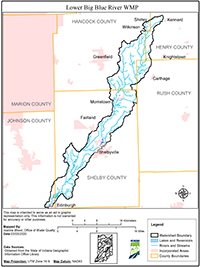Summary
The Lower Big Blue River (LBBR) Watershed project was initiated by the Shelby County Soil and Water Conservation District (SWCD) for the purpose of generating interest in conservation while drawing attention to the condition of the waters within its boundaries. It is concerning, to residents that are aware, that local waters are not surrounded by adequate best management practices and that bacteria, sediment, and nutrients are loading into waters used for recreation. In 2014, Indiana Department of Environmental Management published a Total Maximum Daily Load (TMDL) for the Lower Big Blue River Watershed for the Escherichia coli (E. coli) bacteria. In 2016, the Shelby County SWCD received a 205j grant from the Indiana Department of Environmental Management to develop a watershed management plan for the Lower Big Blue River Watershed.
The LBBR Watershed drains one 10 digit Hydrologic Unit Code (HUC) watershed (0512020408) that includes seven subwatersheds. The watershed drains an area of approximately 112,291 acres (175 square miles) and is 78% row crop agriculture in soybean/corn rotation. Nearly 19% of watershed soils are considered highly erodible or potentially highly erodible. Based on water quality sampling and the watershed inventories conducted during the LBBR watershed project, nutrients, sediment, and E. coli, were identified as water quality problems in the watershed.
The WMP is a strategy for achieving water quality goals by characterizing the watershed, setting goals and actions steps, and developing an implementation plan to address documented problems. The Lower Big Blue River WMP meets the requirements of IDEM’s 2009 Watershed Management Plan Checklist and was approved by IDEM and EPA in February 2020.

